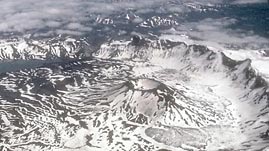Teachers' Domain - Digital Media for the Classroom and Professional Development
User: Preview

Source: National Park Service
Most people will never see the eruption of an active volcano. Even so, evidence of these dramatic displays can be found all over the world. In fact, more can be learned about some aspects of volcanic activity by exploring evidence left by past eruptions than by watching an eruption in progress. This interactive resource adapted from the National Park Service explores eight volcanic features and describes how they form.
All volcanic eruptions are fueled by heat released from magma, a mixture of molten rock, suspended minerals, and dissolved gases. Most rocks melt at temperatures between 800° C and 1,200° C (1472° F and 2192° F). This occurs in layers of Earth's mantle called the lithosphere and asthenosphere, at depths between 50 km and 250 km (31 mi and 155 mi) beneath the surface. Because magma is molten, it is less dense than the surrounding rocks. This causes magma to move upward and eventually come into contact with and intrude into portions of Earth's crust or to be released through volcanic vents.
Once cooled and solidified, volcanic material records the movement of magma and other volcanic events within a previously active volcano. Lava flows, for example, provide clues to the types of eruptions that created them. Volcanoes whose magma is viscous and contains high concentrations of dissolved gases produce the lava flows called ʻaʻa, consisting of jagged, chunky blocks. Less violent eruptions are characterized by less viscous lava that flows smoothly for long distances, as seen in the vast expanses of pahoehoe lava flows.
Lava tubes are another sign of relatively non-violent eruptions of pahoehoe lava. These features form when lava at the outer edges of a flow begins to cool and harden, first along the sides of the flow and then on top. Lava in the center of the encasement continues to flow until the generating source stops. Once the last of the flowing lava clears the channel, all that remains is a crusty, hollow tube.
Calderas tell even more about a volcano. These depressions, spanning as much as 25 km (15.5 mi) in diameter, provide direct evidence of the extent of a volcano's network of magma chambers — what vulcanologists call a volcano's "plumbing." They form after a volcano has erupted and its magma chambers are empty. Without the volume and pressure inside these chambers, the weight of the volcano peak is simply too great for the chamber walls to support, and the mountain collapses upon itself.
Other types of volcanic features say as much about current volcanic activity as they do about activity in the past. Many of these involve interactions between molten magma and groundwater. As water seeps through cracks in Earth's crust and contacts magma or volcanic rocks that have not yet cooled, it quickly reaches the boiling point, turns to steam, and races back to the surface. Geothermal features such as fumaroles, geysers, mud pits, and hot springs all signify that volcanic activity is happening not far beneath the surface.
 Loading Standards
Loading Standards Teachers' Domain is proud to be a Pathways portal to the National Science Digital Library.
Teachers' Domain is proud to be a Pathways portal to the National Science Digital Library.
